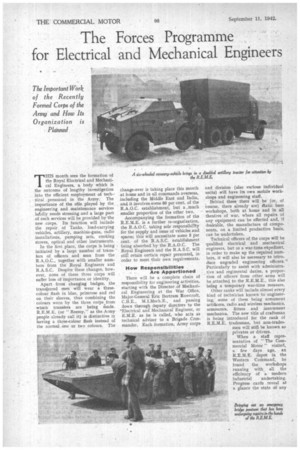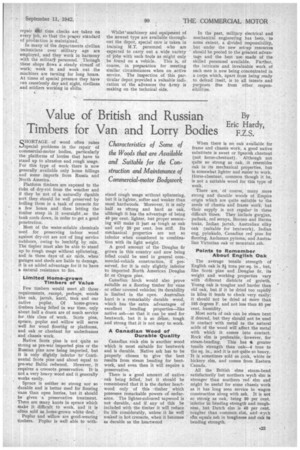The Forces Programme for Electrical and Mechanical Engineers
Page 24

Page 25

If you've noticed an error in this article please click here to report it so we can fix it.
THIS month sees the formation of the Royal Electrical and Mechanical Engineers, a body which is the outcome of lengthy investigation into the efficient employment of tech-, nical personnel in the Army: The importance of the r6le played by the engineering and maintenance services lutally needs stressing and a large part of such services will be provided by the new corps. Its function will include the repair of Tanks, load-carrying vehicles, artillery, machine-guns, radio installations, pumping sets, cooking stoves, optical and other instruments.
In the first place, the corps is being initiated by a large number of transfers of officers and men from the R.A.O.C., together with smaller numbers from the Royal Engineers and R.A.S.C. Despite these changes, however, none of these three corps will suffer loss of importance, or identity.
Apart from changing badges, the transferred men will wear a threecolour flash in blue, primrose and red on their sleeves, thus comibining the colours worn by the three corps from which transfers are being made. R.E.M.E. (or " Reemy," as the Army people already call it) is distinctive in having a three-colour flash instead of the normal one or two colours. The change-over is taking place this month at home and in all commands overseas, including the Middle East and India, and it involves some 60 per cent, of the R.A.O.C. establishment, but a ,much smaller proportion of the other two.
Accompanying the formation of the R.E.M.E. is a further re-organization, the R,A.O.C. taking sole responsibility for the supply and issue of vehicles and spares; this will necessitate some 5 per cent, of the R.A.S.C. establishment being absorbed by the R.A.O.C. The Royal Engineers and the R.A.S.C. will still retain certain repair personnel., in order to meet their own requirements.
How Responsibilities
Are Apportioned There will be a complete chain of responsibility for engineering activities, starting with the Director of Mechanical Engineering at the War Office. Major-General Eric Bertram Rowcroft, C.B.E., M.I.Mech.E., and passing down though deputy directors to the 'Electrical and Mechanical Engineer, or E.M.E. as he is called, who acts as technical adviser to a Brigade Commander. Each formation, Army corps
and division (also various individual units) will have its own mobile workshops and engineering staff.
Behind these there will be (or, of course, there already are) -atic base workshops, both at home and in all theatres of war, where all repairs of any equipment can be effected and, if desirable, the manufacture of components, on a limited production basis, can be undertaken,
Technical officers of the corps will be qualified electrical and mechanical engineers, but as a war-time expedient, in order to make up the required numbers, it will also be necessary to introduce ungraded engineering officers.' Particularly to assist with administrative and regimental duties, a proportion Of officers from other arms will be attached to the R.E.M.E., this also being a temporary war-time measure, Other ranks will include almost every kind of technician known to engineering, some of them being armament artificers, radio and wireless mechanics, armourers, fitters and instrument mechanics. The new title of craftsman is being introduced for the rank of R.E.M.E, tradesman, but non-tradesmen will still be known as privates or drivers.
When a staff representative of " The Commercial Motor" visited, a few days ago, an R.E.M.E. depot in the Western Command, he found the. workshops running with all the efficiency of a modern
industrial undertaking. Progress cards reveal at a glance the state of any
repair iffid time checks are taken on every job, so that the proper standard of production is maintained.
In many of the departments civilian technicians over military age are employed, and they work in harmony with the militarY personnel. Through these shops flows a steady streani of work; week in and week out the machines are turning for long hours. At times of special pressure they have run ceaselessly day and night, civilians and soldiers working in shifts.
a Whilsrmachinery and equipment of the newest type are available throughout the depot, special care is taken in training M.T. personnel who are expected to carry out a wide variety of jobs with such tools as might only be found on a vehicle. This is, of course, in preparation for meeting similar circumstances when on active service. The inspection of this particular depot provided a valuable indication of the advances the Army is making on the technical side. In the past military electrical and mechanical engineering has been, to some extent, a divided responsibility, but under the new set-up resources should be pooled to the greatest advantage and the best use made of the skilled personnel available. Further, the intricate and invaluable work of such men is now being concentrated in a corps which, apart from being ready to defend itself, is to all intents and purposes free from other responsibilities.




















































